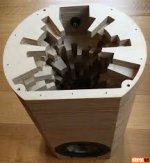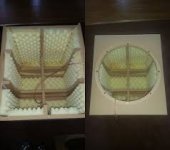Hey everyone,
I've worked on a few speaker enclosure designs and use 3d printing to create them. (Ignoring the issues with 3d printing a resonance for now, I've got a few ideas how to get around this).
But what I would like to do is create non flat internal faces as the printer should be able to make this easily. However, I do not know how to create these in fusion 360 or any other cad for that matter. Has anyone got any tips they could share?
Pics attached to try and get across what I mean. Doesn't have to be these patterns.
Thanks
I've worked on a few speaker enclosure designs and use 3d printing to create them. (Ignoring the issues with 3d printing a resonance for now, I've got a few ideas how to get around this).
But what I would like to do is create non flat internal faces as the printer should be able to make this easily. However, I do not know how to create these in fusion 360 or any other cad for that matter. Has anyone got any tips they could share?
Pics attached to try and get across what I mean. Doesn't have to be these patterns.
Thanks
Attachments
I believe the term I'm looking for is a diffuser.
Found this article which is very manual but I think this may be the way: https://forums.autodesk.com/t5/fusi...-irregular-3d-geometric-pattern/td-p/11365355
Found this article which is very manual but I think this may be the way: https://forums.autodesk.com/t5/fusi...-irregular-3d-geometric-pattern/td-p/11365355
If the design is complex and parameterised so it can be optimised for some purpose writing a script is likely to be significantly more efficient than conventional CAD point-and-click. For example but there are plenty of others in python and other scripting languages. Many commercial CAD packages including Fusion (don't know about the free version?) also include addon scripting options but they can be a bit cumbersome to use compared to UIs developed for scripting.
I am curious about why you want to diffuse and scatter the internal sound given the long wavelengths involved and the better technical performance, lower cost and increased internal volume/smaller external volume of simply using sound absorbing material. It wants to be in the right place though to be effective so not like the stuffing in your right hand image which is placed where it is least effective at absorbing sound.
I am curious about why you want to diffuse and scatter the internal sound given the long wavelengths involved and the better technical performance, lower cost and increased internal volume/smaller external volume of simply using sound absorbing material. It wants to be in the right place though to be effective so not like the stuffing in your right hand image which is placed where it is least effective at absorbing sound.
I’m just exploring options. But pleased you said about sound dampening materials as that is what I’m more likely to do.
So I guess my next question is is there any benefit of using a diffuser over just using sound dampening?
So I guess my next question is is there any benefit of using a diffuser over just using sound dampening?
Significant technical benefits may be derived from placing large diffusers on walls in a room. There are no technical benefits of which I am aware of placing complex shapes on the inside wall of a cabinet because the long wavelengths of low frequency sound won't see it and the high frequencies will have been absorbed by stuffing. It is possible to influence the driver loading and get some sound absorption using cavities and holes but it is expensive, complex and ineffective w.r.t absorption at low and often mid frequencies. It is possible with very complex geometries (e.g. metamaterials) to get something that is as effective as stuffing at high frequencies. Given the high cost and complexity it makes no engineering sense but it might make marketing sense as has been demonstrated recently by KEF. So it can be a way to distinguish a speaker.
Thanks Andy this is very helpful.
I started looking into metamaterials the other day, they sound very interesting but in this case I will stick with dampening material for this build. Thanks again for your expertise
I started looking into metamaterials the other day, they sound very interesting but in this case I will stick with dampening material for this build. Thanks again for your expertise

